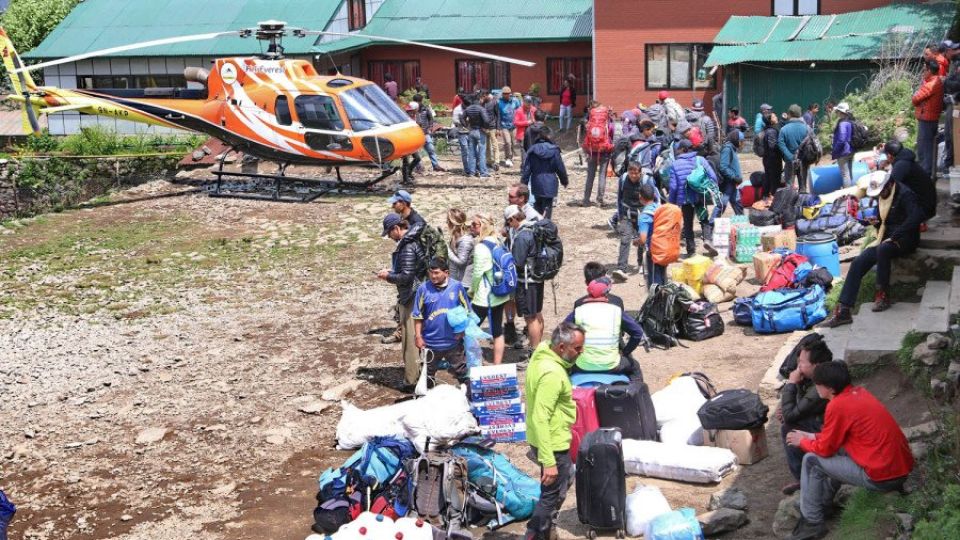December 19, 2024
KATHMANDU – The issue of banning helicopter sightseeing tours in one of the world’s most iconic natural regions, home to the planet’s tallest mountain, from January 1, has turned nasty.
As state bodies at all levels, including the local government, are staking their unflinching claim to the skies over the Everest region, serious questions have been raised about Nepal’s high-end tourism prospects. Experts say such a jurisdiction issue may spill over to other national parks if this issue is not handled well.
The federal government, however, has not taken the matter seriously.
On December 12, the Sagarmatha National Park, which houses the world’s tallest peak, issued directives restricting commercial choppers from flying over it. On December 13, the civil aviation regulator responded that the park has no legal ground to enforce such a ban.
After three days, on Monday, the Khumbu Pasang Lhamu Rural Municipality, the local federal unit, issued a strongly worded statement against commercial chopper operations in the Everest region.
“We request the Trekking Agencies Association of Nepal and all travel agencies operating within this rural municipality to refrain from booking or selling any packages that include helicopter flights for the Khumbu region,” according to the statement.
“If any individual or agency engages in such activities after this notice, and if it causes any obstacles or issues in this region, the rural municipality will not be held accountable. This press release has been issued to inform all concerned parties.”
The municipality added: “Beyond Lukla, only rescue and sling flights that comply with the laws and regulations of Sagarmatha National Park will be allowed. All other commercial helicopter flights will be banned entirely from January 1.”
As per the rural municipality directive, a recommendation must be obtained from the health institution at the flight site for emergency rescues. A health professional must be present on the flight.
If further treatment outside the region is required, patients must undergo a test at Pasanglhamu Nicole Niquille Hospital in Lukla and get a mandatory recommendation from the hospital.
“Henceforth, only rescue and sling flights in compliance with the laws and regulations of Sagarmatha National Park will be permitted beyond Lukla,” the municipal statement reads.
The statement comes in response to one by the Civil Aviation Authority of Nepal, which vowed not to follow the rules imposed by the national park and asked the helicopter companies to continue with their regular flights.
The immediate concern raised by the park is severe noise pollution caused by frequent helicopter flights over the area. The noise disturbs animals, which rely on the park’s relatively undisturbed natural environment. Excess noise can interfere with their feeding, breeding, and other behaviours.
The national park has tasked the Nepal Army and local youth groups with monitoring the ban, a development chopper operators see as a serious security concern.
“The noise generated by choppers is alarming,” said Jagat Prasad Bhusal, chief administrative officer of the Khumbu Pasang Lhamu Rural Municipality.
“Every day, it feels like the loud noise will blow your ears out.”
On November 13, the rural municipality held a discussion inviting ten lawmakers from the upper house of parliament in the Khumbu region. The programme had to be abandoned due to excessive noise of choppers.
“Most complaints are from schools. The noise has affected the studies of children.”
Every day, the rural municipality receives hordes of complaints from locals about noise pollution.
“We do not oppose flights, but the helicopter companies are adamant about not obeying rules. They land anywhere they wish,” said Bhusal.
According to the rural municipality, most helicopters are yet to pay the Rs200,000 annual “business tax” imposed by the local government.
The park, which covers an area of 1,148 square kilometres in the Solukhumbu district, was established on July 19, 1976. In 1979, in recognition of its superlative natural surroundings and unique culture, it was put on the UNESCO World Heritage Sites list.
The national park said noise pollution in the wildlife habitat has resulted in behavioural changes in animals.
The sounds can cause wild animals to leave their habitats and run into the villages. The park authority said accidents involving animals like Himalayan tahr and Himalayan goral, a goat-antelope with a short tail and backwards-pointing horns, are rising.
The shy natural goral is found foraging and sheltering on rocky faces of mountains.
The animals jump off the cliffs in shock when choppers fly at low altitudes with big sounds. Their deaths are rising.
The park authority said they had done justice to the wild animals by stopping commercial flights above the national park.
Tourism ministry officials said they are aware of the issue. “We have been discussing the matter with the forest ministry,” said Ram Krishna Lamichhane, spokesperson for the tourism ministry. “We hope the issue will be sorted out soon.”
The tourism fraternity warned that the Everest sightseeing ban could harm Nepal’s tourism, which is still struggling to recover to pre-Covid levels. The park is also a major tourist attraction, especially for trekking to the Everest base camp.
The Everest sightseeing tour, which falls into an expensive, high-end tourism segment, is a lifelong dream of many people around the world.


